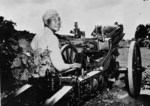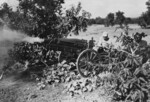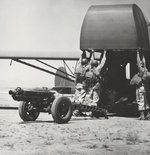75 mm How M1 Field Gun
| Country of Origin | United States |
| Type | Field Gun |
| Length | 3.680 m |
| Barrel Length | 1.380 m |
| Weight | 607.000 kg |
| Ammunition Weight | 6.40 kg |
| Rate of Fire | 5 rounds/min |
| Range | 8.787 km |
| Muzzle Velocity | 381 m/s |
Contributor: C. Peter Chen
ww2dbaseThe 75-mm Pack Howitzer M1 artillery pieces were designed in the United States in the 1920s with transportability in mind. The tube-and-breech artillery pieces were placed atop the M1 carriage with wooden wheels. They had a hydropneumatic recoil system, with recoil buffer and recuperator located under the barrel. They could be broken down into several pieces so that they could each be transported by six pack animals if the terrain was unsuitable for the M1 carriages. Each pack animal load ranged between 73 and 107 kilograms each; they were:- Tube
- Breech and wheels
- Top sleigh and cradle
- Bottom sleigh and recoil mechanism
- Front trail
- Rear trail and axle.
Although the 75-mm Pack Howizer M1 artillery pieces were made standard for the United States Army in 1927, they were produced in very low numbers; by 1940, only 91 were in service. In Sep 1940, however, production ramped up as the United States prepared for the potential involved in WW2. These post-Sep 1940 pieces differed from their predecessors by being placed atop M8 carriages, which had metal wheels with pneumatic tires. These new variants were also slightly changed so that they could be broken down to nine parts instead of only six, so that they could be dropped by parachutes.
A few of the M3 variants were also built, which were classified as field guns as opposed to pack howitzers, though only 349 were built. The more commonly seen pack howitzer variant had a total production count of 4,939 between Sep 1940 and Dec 1944.
During WW2, 75-mm Pack Howitzer M1 artillery pieces were used by both the United States Army as well as the United States Marine Corps; those used by the US Army were typically found in airborne units. Other Allies also received some examples of the 75-mm pack howitzers. 826 of them were sent to the United Kingdom and the Commonwealth forces, 637 to China, 68 to France, and 60 to various Latin American countries. Additionally, China also received 125 of the field howitzer variants.
After the war, they received the new designation M116.
Source: Wikipedia. ww2dbase
Last Major Revision: Jan 2008
75 mm How M1 Field Gun Interactive Map
Photographs
 |  |  |  |
Please consider supporting us on Patreon. Even $1 per month will go a long way! Thank you. Please help us spread the word: Stay updated with WW2DB: |
Visitor Submitted Comments
All visitor submitted comments are opinions of those making the submissions and do not reflect views of WW2DB.
Search WW2DB
News
- » US Women's Army Corps "Six Triple Eight" Awarded with Congressional Gold Medal (30 Apr 2025)
- » Wreck of Soviet Submarine M-49 Found (10 Apr 2025)
- » Japanese Emperor Visited Iwoto (Iwo Jima) (8 Apr 2025)
- » Race, Holocaust, and African-American WW2 Histories Removed from the US Naval Academy Library (7 Apr 2025)
- » US Government Plans to Purge WW2 Information (17 Mar 2025)
- » See all news
Current Site Statistics
- » 1,167 biographies
- » 337 events
- » 44,617 timeline entries
- » 1,244 ships
- » 350 aircraft models
- » 207 vehicle models
- » 376 weapon models
- » 123 historical documents
- » 261 facilities
- » 470 book reviews
- » 28,514 photos
- » 365 maps
Famous WW2 Quote
"Among the men who fought on Iwo Jima, uncommon valor was a common virtue."Fleet Admiral Chester W. Nimitz, 16 Mar 1945
Support Us
Please consider supporting us on Patreon. Even $1 a month will go a long way. Thank you!
Or, please support us by purchasing some WW2DB merchandise at TeeSpring, Thank you!
12 Jan 2008 06:42:39 AM
At the beginning of World War 11 the USMC replaced the 75mm M1897A2 (Known as The French 75) with the M1A1 pack howitzer. These were issued to three of the four battalions of the two existing Marine Divisions intregal Artillery Regiments (the fourth battalion having the 105 mm M2A1 Howitzer). In Mid 1944 the Battalions equipped with the M1A1 were reduced to two(an additional 105mm Battalion having been added to the establishment in mid-1943 and were completely phased out in late 1945. The M1897A2 continued in service until mid-1942 in the Regimental Weapons Companies of the Marine Infantry Regiments (two guns per Company) but were then thought to be too heavy for man handling and were replaced by 75mm self-propelled M3 Halftracks (and eventually by the M7 105mm SPG from May 1945)